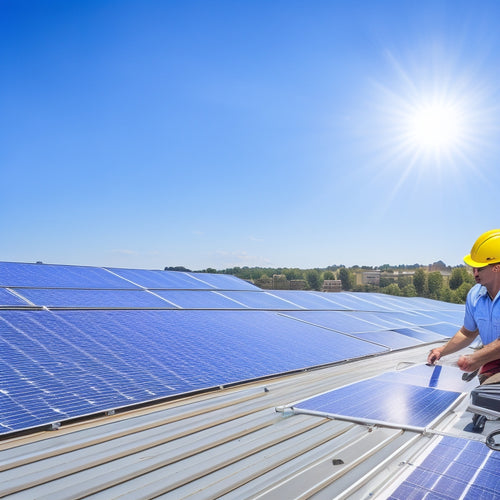
Meeting Europe's Electric Scooter Safety Standards
Share
When manufacturing electric scooters for the European market, you must navigate a complex landscape of regulations and safety norms, where the EU's regulatory framework sets stringent standards for design, performance, and safety features. You'll need to guarantee compliance with EU regulations, covering areas like braking systems, tires, lighting, maximum speed, and battery safety. To succeed, you'll need to prioritize design and manufacturing standards, battery safety, and braking system requirements. Meeting these standards requires a thorough understanding of the certification and compliance process, and by digging deeper, you'll uncover the specifics needed to make sure your electric scooters meet Europe's rigorous safety standards.
Key Takeaways
• EU regulations dictate stringent safety standards for electric scooters, covering design, performance, and safety features to ensure rider safety.
• Compliance with EU standards requires adherence to guidelines for braking systems, tires, lighting, maximum speed, acceleration, and battery safety.
• Battery safety and performance are critical, with thermal management, cell balancing, and high-quality cells meeting European safety standards.
• Reliable braking systems, including regenerative braking, are crucial, with emergency stopping distances and brake performance in wet conditions key considerations.
• Electromagnetic compatibility testing is necessary to prevent malfunctions or interference with other devices, ensuring rider safety and device reliability.
EU Regulations and Safety Norms
As you navigate the European electric scooter market, you're likely to encounter a complex web of regulations and safety norms, which the European Union has established to guarantee the safety of riders and other road users.
The EU's regulatory framework is designed to verify that electric scooters meet stringent safety standards, protecting both riders and pedestrians.
Harmonization efforts have led to the development of a unified regulatory framework, streamlining the compliance process for manufacturers. This framework sets forth specific guidelines for electric scooter design, performance, and safety features.
For instance, the EU has established strict guidelines for braking systems, tires, and lighting, ensuring that riders are visible and in control on the road. Additionally, the EU has implemented regulations governing the maximum speed, acceleration, and battery safety of electric scooters.
Design and Manufacturing Standards
You'll have to make sure that your electric scooter meets the EU's design and manufacturing standards, which dictate everything from the frame's structural integrity to the ergonomic design of the handlebars. These standards are in place to guarantee the safety and reliability of your scooter, and compliance is essential to avoid any potential risks to users.
Here are three key aspects of design and manufacturing standards you should focus on:
-
Material sourcing: Ensure that the materials used in your scooter's construction meet EU standards for quality and safety. This includes the frame, wheels, brakes, and other components.
-
Supply chains: Verify that your supply chains are transparent and reliable, with a clear audit trail for all components and materials used.
-
Manufacturing processes: Implement robust manufacturing processes that ensure consistency and quality in every scooter produced.
Battery Safety and Performance
Your electric scooter's battery is an important component that requires careful consideration to guarantee both safety and peak performance. You need to confirm that your battery meets the stringent safety standards set by the European Union.
One key aspect to focus on is thermal management, which involves regulating the battery's temperature to prevent overheating, a common cause of electrical fires. A well-designed thermal management system will help maintain a stable temperature, reducing the risk of thermal runaway.
Another vital aspect of battery safety is cell balancing. This involves ensuring that each cell in the battery pack is charged and discharged uniformly to prevent overcharging or undercharging, which can lead to battery damage or even failure. By implementing cell balancing, you can significantly decrease the risk of battery-related accidents.
Additionally, it's important to select high-quality battery cells that meet European safety standards, such as those set by the International Electrotechnical Commission (IEC). By prioritizing battery safety and performance, you can create an electric scooter that not only meets but exceeds European safety standards.
Braking System Requirements
When designing an electric scooter, it's crucial to prioritize a reliable braking system that meets European safety standards, as faulty brakes can lead to accidents and injuries. You must prioritize a braking system for your scooter that can handle various scenarios, including emergency stopping.
To meet the standards, consider the following key requirements:
-
Regenerative Braking: This feature captures some of the kinetic energy and converts it back into electrical energy, reducing wear on the brakes and increasing overall efficiency.
-
Emergency Stopping Distance: Your scooter's braking system should be able to bring the vehicle to a stop within a reasonable distance, even at high speeds.
-
Brake Performance in Wet Conditions: The brakes should maintain their performance even when riding in wet conditions, ensuring the scooter can still come to a safe stop.
Tire and Wheel Safety Features
As you examine the tire and wheel safety features of electric scooters in Europe, you'll notice that tread patterns play an important role in ensuring traction and stability.
You'll want to look for scooters with tread patterns that are specifically designed to handle various road surfaces and weather conditions.
Additionally, you'll need to check if the scooter's wheel locking mechanisms are secure and reliable to prevent wheel detachment during operation.
Tread Patterns Matter
Riders can greatly reduce their risk of accidents by choosing electric scooters with tread patterns that effectively channel water, debris, and other obstructions away from the tire's surface. A well-designed tread pattern can markedly improve your scooter's grip performance, especially on wet or slippery surfaces.
When shopping for an electric scooter, look for tires with tread patterns that feature:
- Deep grooves to evacuate water and debris quickly
- Angled tread blocks to enhance traction and stability
- Siped tread surfaces to increase grip on smooth surfaces
A good tread pattern is essential for tire durability, as it helps to distribute pressure evenly across the tire's surface. This reduces the risk of uneven wear, which can lead to tire failure.
Wheel Locking Mechanisms
You can further enhance the safety of your electric scooter by ensuring it's equipped with reliable wheel locking mechanisms. These mechanisms prevent the wheels from coming loose while in motion and minimize the risk of accidents caused by wheel detachment. They are important in preventing wheel-related accidents, especially during high-speed rides or when traversing rough terrain.
Additionally, wheel locking mechanisms provide an added layer of security against scooter theft. When parked, a secure wheel lock ensures that your scooter remains in place, reducing the risk of theft or tampering. Look for scooters with robust wheel locking systems that can withstand various environmental conditions and usage patterns.
Additionally, consider scooters with advanced features like GPS tracking and alarm systems to further enhance parking security. By prioritizing wheel locking mechanisms, you can ride with confidence, knowing your scooter is secure and reliable.
Rider Protection and Visibility
Helmets and protective gear are essential components of Europe's electric scooter safety standards. Manufacturers are required to ensure their products comply with rigorous testing protocols to secure a safe riding experience.
As a rider, you'll want to verify that your helmet design meets the standards set by the European Union. This includes impact resistance, penetration resistance, and retention system testing.
When it comes to visibility, there are several factors to consider:
- Reflective gear: Verify that your helmet and clothing have reflective strips or decals to increase visibility in low-light conditions.
- High-visibility colors: Opt for helmets and gear in bright, eye-catching colors to make yourself more visible to motorists and pedestrians.
- Additional lighting: Consider adding lights or reflectors to your scooter to increase visibility from the side and rear.
Electromagnetic Compatibility Tests
Before hitting the European roads, electric scooters must undergo rigorous Electromagnetic Compatibility (EMC) tests to verify they don't interfere with other electronic devices or compromise safety-critical systems. You'll need to guarantee your e-scooter complies with the EU's EMC Directive, which sets limits on electromagnetic interference (EMI) emissions.
During these tests, your scooter will be subjected to various electromagnetic environments to assess its immunity to external interference. This includes exposure to radiated emissions from other devices, as well as conducted emissions through power and signal cables. The goal is to confirm your scooter won't malfunction or cause electromagnetic interference that disrupts other devices, such as cardiac pacemakers, radios, or navigation systems.
You'll need to conduct a range of tests, including radiated emissions testing, which measures the electromagnetic energy emitted by your scooter. Additionally, you'll need to assess the scooter's susceptibility to electromagnetic pulses, electrostatic discharges, and power-frequency magnetic fields.
Certification and Compliance Process
Your electric scooter's certification and compliance process begins with a thorough assessment of its technical documentation, including design specifications, test reports, and user manuals. This is a critical step in guaranteeing your scooter meets Europe's stringent safety standards.
Next, you'll need to prepare for an audit, which involves a detailed examination of your scooter's design, production, and testing processes. This is where you'll need to provide evidence of conformity with EU regulations, including insurance requirements. Be prepared to provide detailed records of your scooter's performance, safety features, and user instructions.
Here are three key aspects of the certification and compliance process to keep in mind:
-
Technical File: A complete file containing all technical documentation, test reports, and user manuals.
-
Audit Procedures: A detailed examination of your scooter's design, production, and testing processes to ensure adherence to EU regulations.
-
Insurance Requirements: Proof of liability insurance to cover potential damages or injuries caused by your electric scooter.
Frequently Asked Questions
What Is the Maximum Weight Capacity for Electric Scooters in Europe?
Imagine you're Emma, excited to ride your new e-scooter through Amsterdam's canals. You should know that, for a safe ride, the maximum weight capacity in Europe is typically around 120 kg (264 lbs), considering various rider profiles and weight limits.
Can I Use My Electric Scooter on Public Transportation in Europe?
When traveling in Europe, you'll find that foldable designs make electric scooters more convenient, but airport restrictions often prohibit them in terminals, so you'll need to check with your airline and local transit authorities before bringing yours on public transportation.
Are There Specific Rules for Electric Scooter Usage in Bike Lanes?
'A million questions swirl in your mind, but let's explore the most pressing one: yes, there are specific rules for electric scooter usage in bike lanes, involving lane priority and traffic integration, so you'll need to research local regulations to ride safely.'
Can I Ride My Electric Scooter on Sidewalks in Europe?
"You'll need to check local restrictions, as sidewalk riding laws vary across Europe. Generally, pedestrians have priority, so consider bike lanes or roads instead, unless signs or local authorities explicitly permit sidewalk use."
Are Helmets Mandatory for Electric Scooter Riders in All European Countries?
'As you ride through Europe's scenic landscapes, you wonder: are helmets mandatory for electric scooter riders? Yes, but with age exemptions and varying rural enforcement, it's important to research local regulations to guarantee a safe, thrilling adventure.'
Related Posts
-

Top Picks: Van-Friendly Panel Kits to Buy Online
You're about to hit the open road, and you need a reliable source of power to keep your van's essentials running smoo...
-

What Does Solar Panel Maintenance Really Cost?
You can expect to pay between $1,500 to $2,500 per year for solar panel maintenance, with costs influenced by your sy...
-

Best Vehicle Chargers to Keep You Moving
You're looking for a reliable vehicle charger to keep your devices powered up and stay connected on the go. Solar cha...


